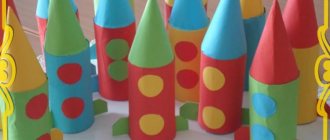Summary of organized play activities for children in the middle group “How the guys helped the little bunny”
"Give me a smile"All the children gathered in a circle.
I am your friend and you are my friend.
Let's hold hands tightly
And let's smile at each other.
The teacher draws the children's attention to a picture of a forest.
IN.:
Guys, do you want to go to the forest?
D.:
Yes.
IN.:
Then I will ask you to divide into 2 teams and stand behind each other. Each of you will have to walk along a narrow short and wide long path. The task must be completed quietly so as not to scare away the forest inhabitants. Let's all meet on the green clearing.
Well done!
IN.:
Guys, what paths did we meet on the way? Which path was easy to follow and which was difficult? Why?
Children's answers
IN.:
Oh! Someone is crying, I'll go and have a look.
Guys, a little bunny has come to us.
Probably the little bunny came to us for a reason, something happened to him, I’ll ask him.
The little hare says that he has nowhere to live. He really asks us to help him build a house, but to do this we must solve difficult tasks. He couldn’t cope alone, so he came to us for help.
IN.:
Well, guys, let's help our little bunny complete his tasks?
D.:
Yes
IN.:
Then also quietly go to the stump chairs.
Here is the first task: “To build a house you need to choose a clearing where birch and spruce trees grow.”
Look, there are trees in the forest clearing. How many are there?
D.:
A lot of.
What are more birch trees or fir trees? Why? What needs to be done so that there are equal numbers of birches and fir trees? Here is another birch tree. What can we say now about the number of birch trees and fir trees? That's right, they are equal!
How many mushrooms are there in the clearing? How many flowers?
D.:
No one.
IN.:
Well done! We did it.
IN.:
And here is the next task.
The little bunny gave us bags. Let's see what's in my bag?
Pasha come to me, close your eyes and feel what is there.
Pasha: Geometric figures.
IN.:
Guys, go to the tables and take 2 geometric shapes out of the bag.
Raise your hand, those who got brown rectangles? Green circles? Yellow square? Red triangle? Green triangle?
Which object has a triangular shape? Which object is square? Which object is rectangular in shape? Which object is round in shape?
Children's answers
IN.:
Guys, using these geometric shapes, I propose to build a diagram of a bunny’s house on a sheet of paper. It will be located between birch and spruce.
IN.:
What's to the right of the house? What's to the left of the house?
Children build with their geometric shapes.
Well done, you also coped with this task. Now let's rest a little.
The little bunny says he wants to play with us.
They are jumping and jumping in the forest. Hares are gray balls (Hands near the chest, like the paws of hares; jumping). Jump - hop, jump - hop - The little bunny stood on a stump (Jumping forward - back) Lined everyone up in order, began to show exercises. One! Everyone walks in place. Two! They wave their hands together. Three! They sat down and stood up together. Everyone scratched behind their ears. They stretched for four. Five! They bent over and bent over. Everyone stood in a row again and walked like a squad.
IN.:
Oh! Look, guys, there's something here! Those are stripes! Look how different they all are; There are long ones and short ones. Let's collect them! Everyone will take two strips so that there is enough for everyone.
Have you collected it?
The teacher asks the children which strips they have in their hands.
IN.:
Okay, well done!
IN.:
Guys, we have two baskets. Place the long strips in the yellow bin and the short strips in the green bin. Well done!
The little bunny is so happy! You helped him do all the difficult tasks. Now he has a diagram of the house. Let's say goodbye to him!
They say goodbye.
IN.:
It's time for us to return to the group too.
And we will return along the same paths along which we came here. They lined up one after another.
Guys, let's remember what interesting tasks we performed? Did everything work out for you? What did you like?
Guys, you helped the bunny a lot, but our journey is over.
Outdoor game in the middle group
GAPOU SO "Kamensk-Ural Pedagogical College"
Industrial practice construct PM.01 organization of activities aimed at strengthening the child’s health and physical development.
Students of group 23 B Akulenko Daria Romanovna
specialty 44.02.01 “Preschool education”
DOO:
MBDOU No. 41
Children's age:
4-5 years
Group teachers:
Stepochkina Yulia Nikolaevna, Kolyasnikova Ulyana Mikhailovna
Head of practice:
Alyokhina Larisa Gennadievna
Educational area
: “Physical development”, “Social and communicative development”
Subject:
Colored cars
Form
of the lesson:
plot-game
Activities:
motor, gaming, communicative, outdoor game
Forms of organization of activities:
individual, group.
Planned result
- Children show interest in physical exercise and need for physical activity.
- Children perform play actions in accordance with the role;
- Children play according to the rules of the game and follow safety precautions;
- Children demonstrate physical qualities (speed, coordination of movements). They know how to control and manage their movements. Children are attentive and oriented in space.
- Children perform basic movements - walking, running in different ways (loose walking, light running).
- Children interact with each other and the teacher.
Target:
development of attention in children, the ability to distinguish colors and act on a visual signal, development of physical qualities (speed, dexterity), development of motor activity of children through outdoor play.
| Objectives of joint activities | Tasks taking into account the characteristics of the group’s students |
Educational tasks:
Developmental tasks:
Training tasks:
|
List of used literature.
- Federal state educational standard for preschool education. Order of the Ministry of Education and Science of the Russian Federation dated October 17, 2013 N 1155
- Resolution of the Chief State Sanitary Doctor of the Russian Federation dated May 15, 2013 N 26 “On approval of SanPiN 2.4.1.3049-13 “Sanitary and epidemiological requirements for the design, content and organization of the operating mode of preschool educational organizations”
- From birth to school: An approximate basic general education program for preschool education / ed. NOT. Veraksy, T.S. Komarova, M.A. Vasilyeva. – M.: MOSAIC SYNTHESIS, 2014. – 304 p.
- Collection of outdoor games. For classes with children 2-7 years old / Author-comp. E. Ya. Stepanenkova - M.: MOZAYKA-SYNEZ, 2019.-144 p.
Principles of preschool education (FSES DO):
- building educational activities based on the individual characteristics of each child, in which the child himself becomes active in choosing the content of his education, becomes the subject of education;
- assistance and cooperation of children and adults, recognition of the child as a full participant (subject) of educational relations;
- creating a favorable social situation for the development of each child in accordance with his age and individual characteristics and inclinations;
- formation of cognitive interests and cognitive actions of the child in various types of activities;
- age adequacy of preschool education (compliance of conditions, requirements, methods with age and developmental characteristics).
Principles of education:
formation of a personal style of relationships with peers and teachers, creation of a positive emotional background and an atmosphere of emotional uplift, education through interaction.
Principles of training:
the principle of learning in the zone of proximal development, the principle of systematicity and consistency.
Principles of physical education:
the principle of continuity, the principle of health-improving orientation.
Education methods
: methods for children to comprehend their social experience (conversation), stimulation method (encouragement).
Teaching methods
: method of developing cognitive interest (stimulation with entertaining content), information-receptive method (explanation, instructions).
Outdoor game plan:
- Motivation for joint activities
- Game planning
- Implementation of the game plan
- Summing up the game
- Openness
Progress of the outdoor game
| Stages of the game | Methods | Contents of the teacher’s activities | Contents of children's activities | Planned result | |||
| 1. Motivation for joint activities Task: motivate children to work together, create a positive mood | Conversation | The teacher attracts the children's attention. — Guys, today, on the way to kindergarten, I saw this picture: The boy was crossing the road at a red traffic light and a policeman stopped him. The teacher asks leading questions. Why do you think the policeman stopped the boy? Maybe he did something wrong? The teacher listens to the children's answers — Guys, you know the rules of the road, right? This means you can tell us what colors the traffic light has and which colors we can cross the road with and which ones are prohibited. That's right. You are so great! -You know how to cross the road correctly when we are pedestrians. -Do you want to play the role of a machine? Children answer . -Then I suggest you play the game “Colored Cars” The teacher listens to the children's answers. | Children listen to the teacher, actively answer questions, remember the rules of the game | Children are motivated to work together | |||
| 2.Game planning Tasks:
3 Implementation of the game concept Tasks:
| Conversation Instructions | The teacher explains the rules of the game. -In this game you all become real cars, first you will need to all line up in one line. -Each of you will have a steering wheel of a certain color in your hands. When I raise a flag of the same color as your steering wheel, you should run into your lanes. When you drive on your tracks, you can honk like real cars! But as soon as I lower the flag of your color, you must stop! -Attention! You need to run carefully and not bump into each other or other objects in the group. If we have an accident, I, as a policeman, will take the participants in the accident to my station. Those. you are out of the game. Did everyone understand the rules of the game? The teacher and the children discuss safety rules. The teacher monitors the game and compliance with safety rules, and provides targeted assistance. The game is repeated twice with a change of roles. | Children listen to the rules of the game, as well as safety rules. Children play following the rules of the game. | Children want to negotiate with each other and are familiar with the rules of the game and safety rules. Children play according to the rules discussed with the teacher, act on the teacher’s signal | |||
| 3. Summing up the game Task: develop the ability to analyze the process and results of joint activities | Conversation Encouragement and reprimand | The teacher sums up the outdoor game -So you and I played as cars, did you like it? The teacher listens to the children's answers -Well done! You and I had a great ride along our wonderful paths and repeated the rules of the road Now it's time to turn into pedestrians again | Children answer the teacher’s questions and analyze. | Children analyze the results of joint activities and draw conclusions | |||
| 4. Openness Task: to orient children to independent activity in restricted moments. | Conversation Setting up a system of perspectives | The teacher emotionally stimulates the children -Guys, you've been in the role of cars, who else can you play this game with next time? -Very good! -Do you play outdoor games with your parents at home? The teacher listens to the children's answers -Well done! Keep playing outdoor games and you will always be in a good mood. | Children answer the teacher’s questions and agree with him. | Children are focused on joint activities in routine moments. | |||




